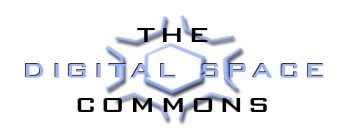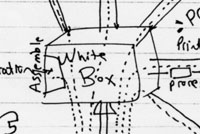

 |
 |
Digital
Space and Elixir Technologies
Development of "White Box" next generation products/services
sketches explained
| The following is an explanation of the a first treatment of the "White Box" products and services brainstorming session sketches developed in May and June 2003. The original pages can be viewed here. Below we have sought to extract elements of the sketches and provide more detailed explanation. |
1. Functional
|
Functional aspects of the White Box (WB) are pictured above. The WB can deliver the interactive web experience, the archive and the print (high volume or locally) for document applications driven by enterprise database systems. The WB is based on the idea of "template assembly" rather than of formatted documents (a la Opus). The WB would be offered as a turn-key solution for all new applications or as an integrative component (database application) to be integrated directly into the customer's database platforms. More on this later. WB applications would be targeted at high value documents where premiere customers are served by top caliber representation and interactivity of documents. Print is a premium service in this scenario and end users can generate their own unique print from their interactive session. This is not a shipped, boxed product but rather a platform to provide high value services to customers who are bringing us in as partners. |
2. Positional
|
Positional aspects of the White Box are described here and by the figure above. A competitor of Elixir, XStream, is shown in the position of a post-processor of database records and business logic, performing high volume PDL (Print Description Languages) and archival generation. Recently XStream has added a facility to generate documents to the web. Alternatively, the WB lives further upstream than XStream by being a peer database or an application running within the customer's own database. WB can also generate high volume print, archive and web interactivity. Howeber, WB web interactivity is likely to better serve the customer's end users as it is tied directly to the business logic and records contained in the database (CRM, accounts or other databases) rather than being generated as an export from the customer's databases. It should be noted that Elixir may in fact not be targeting WB toward the kind of application that XStream facilitates (high volume billing statements) for which there is not much call for web interactivity (other than the availability of an online archive). Indeed, in some cases, WB may utilize XStream as an output engine. In the above scenario, the WB would be selling into an upstream part of an organization's IT budget and management. This is a much more mission critical part of a company's business. Many more competitors would be found here than in the traditional high and medium volume print business. The venture would differentiate itself based on the following:
|
3. Process
|
The Process steps of the use of WB to create a high value, interactive, yet print-ready application, is described in the figures above and below. As WB would be offered as a professional service, elements required from customers would include: template designs (existing print, overlay resources), data records and dialogue, business logic, and corporate look and feel to match to the existing web presence. |
|
Into the hopper go elements of the application to a waiting professional services team which takes the paper print application and through a series of automated and hand-based heuristic conversion tools, redesigns the application for the online environment. Designers apply the brush of high caliber look and feel (graphical treatment and affordance design and user testing) to produce a template into which the data/integration team then must fill in the blanks with customer data and database dialogue processes. Integration with various output technologies, to print and archive, are accomplished next. As the cycle continues the complete application is tested and validated in a rapid prototyping process that depends on scripts (database and web) rather than compiled applications (C/C++). New scripts update development and application building teams on a continuous basis creating a distributed community of expertise that collectively builds the power of the WB toolkit. When the White Box is deployed to deliver the application, professional services team members maintain and update the application by remotely logging in and upgrading scripts. The customer can request a new feature at any time and this will be turned around rapidly, for a service fee. Indeed, if the cusomer opts for it, their own in-house staff can assume responsibility for White Box code. If the WB contains real-time interactive tools (making this a "live documents" application), the customer be able to interact with its end users through the documents and will also have the side benefit of being in contact with professional services staff at all times. Over time as the professional services team would convert more of the customer's applications to the White Box, and be able to ultimately offer outsourcing for the online hosting, end user interaction, high volume print and archive. |
4. Offerings
|
The White box is modular and flexibly offers itself in several variants. The sketch above provides an illustration. In the example shown here, an "e-government" project seeks to pilot a project to those citizens with online access. Online voting would require only local printing (by the voters for their records) and a central database driving the web. As elections grow in size, archival records of online ballots are important so the electronic archive option is added. Finally, as a wide polity of the citizenry must be reached, printed ballots (necessitating high volume output devices) is facilitated by the print options in the WB. In another example, a customer with an e-catalogue business plan may adopt a WB with the web delivery component ony, and over time as they build the lower cost of aquisition customer base, archive and then high volume print (of paper catalogues) is added. |
5. Structure
|
Questions of structure emerged during discussions. While the "flat" open model of Digital Space (as an R & D community) may not be appropriate for the development and professional services portions of this new business, elementes of the "always on" matrix interactivity of these models may be of use for the effort. To make this business function, It will be important to have a rapid rate of flow of information from customer to developer, to professional services provider, to vendor partners. We should keep ourselves open to exploring innovative structural concepts as embodied by the above diagram as we move toward determining the viability and scope of this possible business. |

Return to White Box Project Concept Pages
This page contains
information confidential to Elixir Technologies and DigitalSpace Corporation
(c) Copyright 2003, All Rights Reserved